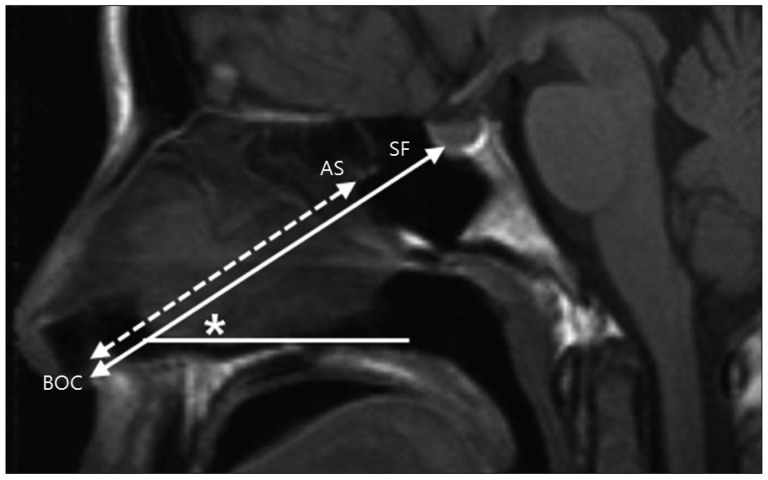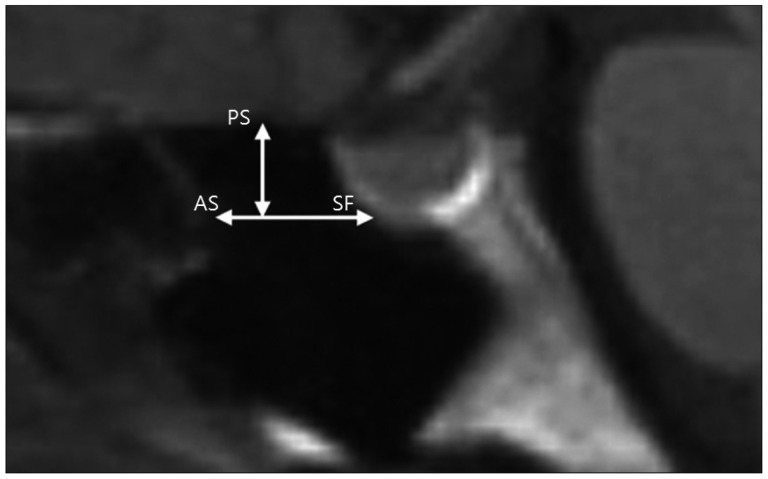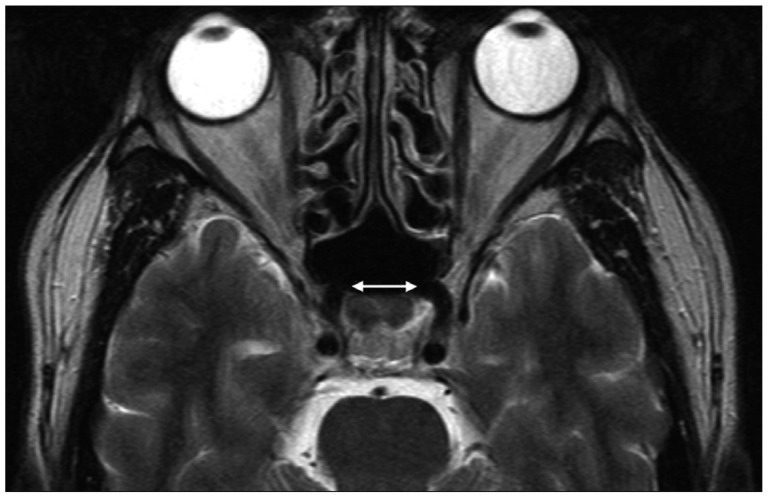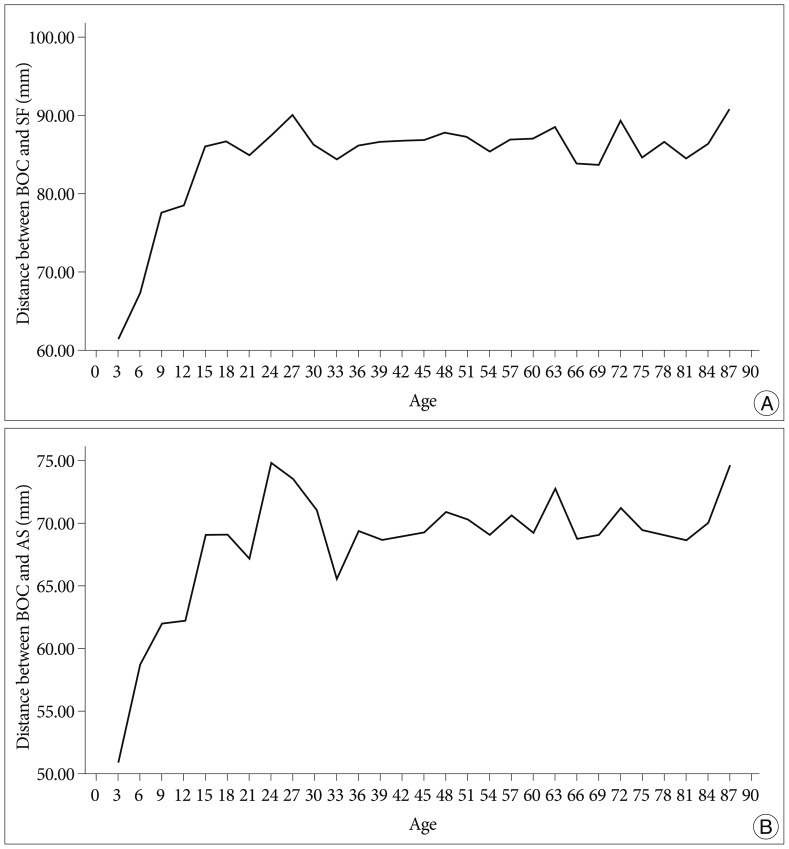Abstract
Objective
To clarify the anatomical correlations of the sphenoid sinus with surrounding structures in the normal Korean population, and to identify surgical landmarks for safe sellar floor dissection in the anterior skull base by endoscopy and microscopy.
Methods
We reviewed the 196 brain magnetic resonance imaging findings showing a normal appearance, and measured the distances between anatomical landmarks.
Results
The mean distances from the base of the columella to the anterior wall of the sphenoid sinus and the sellar floor were 69.71±4.25 mm and 86.26±4.57 mm, respectively in the over 15 age group, and showed the smallest degree of variation among the measurements. The mean angles between the floor of the nasal cavity and the straight line connecting the base of the columella and the sellar floor were 29.45±3.25° and 24.75±4.00° in the over 15 and under 15 age groups, respectively. The mean values of both distances and angles increased with age until 15 years after which no further increases were evident. There were no significant differences in the measurements between males and females or among subjects with different degrees of pneumatization in the over 15 age group.
The endoscopic and microscopic transsphenoidal approach has become a standard procedure for the removal of pituitary tumors as it has numerous advantages compared to the transcranial approach3); this is the least traumatic route to the sella turcica, it avoids the need for brain retraction, and it provides excellent visualization of the pituitary gland and related lesions. Although most of the sphenoid sinuses in adults are well pneumatized, surgeons sometimes encounter cases with poor pneumatization or poor demarcation of the sellar floor in the sphenoid sinus. Although some anatomical studies were reported6,11), there have been few radiological or anatomical studies of the sellar floor, especially from base of collumella, and so safe surgical intervention in such cases is still difficult2). The present study was performed to clarify the anatomical correlations of the sphenoid sinus with surrounding structures in the normal population and to find surgical landmarks for safe sellar floor dissection in anterior skull base surgery with endoscopy or microscopy.
We reviewed all results of brain magnetic resonance imaging (MRI) conducted at our hospital between July and December 2009. The majority were conducted during evaluation of patients presenting with neurological symptoms, such as seizure or headache. Among these, we found 196 MRIs that showed a normal appearance. We reviewed MRIs of normal anatomy as patients with problems in pituitary tend to have variable sizes in anatomical structures. The patients ranged in age from 1 to 86 years (mean : 45.64±24.29 years), and were distributed evenly throughout all age ranges. The gender distribution was 87 males to 109 females.
We selected three candidates for surgical landmarks that could be found easily during surgery : the base of the columella (BOC), the most inferior portion of the anterior wall of the sphenoid sinus (AS), and the planum sphenoidale (PS). Although the distance from anterior nasal spine (ANS) to sphenoid anterior wall had been well reported, ANS is not exposed during endoscopic surgery. So, we chose base of columella, which is always noticeable during endoscopic approach, as candidate for surgical landmark. We measured the distances from BOC to AS and PS was taken and the angle between the floor of the nasal cavity and the straight line connecting BOC and sellar floor (SF) was also measured (Fig. 1). The length between the PS and the most inferior end of sella bulge was defined as a pituitary height and the craniocaudal length between the anterior end of sella bulge and the anterior wall of sphenoid sinus was also taken (Fig. 2). To ensure precise measurements, all measurements were conducted by two physicians each and reevaluated if the differences between two measurements exceeded 15 percents of average. Measurements were performed on T1 or T2 weighted median sagittal image in which the nasal septum could be seen. The distances between both the internal carotid arteries at the most anterior portion of the cavernous (C4) segment in T1 or T2 weighted axial images were measured, to allow investigation of the safe width of sellar dissection (Fig. 3). We also analyzed the degree of pneumatization in the sagittal plane, and divided pneumatization as conchal, presellar, sellar, and postsellar type1,2). Finally, we compared all measurements with the degree of pneumatization, age, and sex, and evaluated the feasibility of these three candidates as surgical landmarks. For statistical comparison, t-test and one-way analysis of variance were performed by using SPSS software, version 16 (SPSS, Inc., Chicago, IL, USA). This study was approved by our institutional review board.
In the over 15 age group, the average distances between the BOC and AS and between BOC and SF were 69.71±4.25 mm and 86.26±4.57 mm, respectively, and also showed the smallest degree of variation, indicating that the distances were consistent among individuals. The mean angle between the floor of the nasal cavity and the straight line connecting BOC and SF (which is related to the direction of the microscope or endoscope during surgery) was 29.45±3.25° in the over 15 age group and 24.75±4.00° in the under 15 age group. The craniocaudal length between the anterior wall of sphenoid sinus and sella was 16.22±2.92 mm and the average of sellar height was 8.54±2.06 mm in the over 15 age group. The mean intercarotid distance (ICD) in the axial cut was 17.61±3.06 mm in the over 15 age group and 13.21±2.28 mm in the under 15 age group (Table 1).
With regard to the degree of pneumatization of the sphenoid sinus, the study population included 15 cases of conchal pneumatization (7.7%), 14 cases of presellar type pneumatization (7.1%), 82 cases of sellar type pneumatization (41.8%), and 85 cases of postsellar type pneumatization (43.4%). As maturation of the sphenoid sinus is not completed until 15 years of age, patients were divided into two groups above and below this age1,10,14). As shown in Table 2, in children under the age of 15, the conchal type was most common (41.2%), with all cases under 8 years being of the conchal type. In the over 15 age group, postsellar pneumatization was the most prevalent type (49.4%).
We analyzed changes in the distances and angles with age by dividing the patients into age groups at intervals of 3 years (Fig. 4). The distances and angles increased with age until age 15, after which these increases leveled off. This trend was particularly apparent when comparing the distances from BOC to SF and to AS.
Table 3 shows the mean distances between landmark points according to the degree of pneumatization including all age ranges. We observed no significant differences between the groups in the measurements conducted. In addition, we found no significant differences in the distances or angles between males and females.
The endoscopic and microscopic transsphenoidal approach is considered the standard approach for surgical treatment of pituitary tumors3). By 1914, Cushing4) had reported a less traumatic sublabial transsphenoidal technique. However, this technique was not widely implemented due to poor illumination and visualization of the operative field. After Hardy popularized the use of the operating microscope in the late 1960s, its magnification and illumination capabilities enabled the removal of even large tumors without significant anatomical disruption, and therefore the transsphenoidal approach was widely adopted9). Several modifications of these microscopic techniques, including the introduction of endoscopy to transsphenoidal surgery, have increased the range of surgical interventions possible.
Despite these developments in surgical technique and equipment, sellar floor dissection remains challenging, particularly when the sphenoid sinus is poorly pneumatized or the sellar bulge is poorly demarcated. Hamid et al.7) reviewed 296 patients who had received pituitary transsphenoidal surgery. Among these, 74 patients showed poor pneumatization in preoperative radiological examination, while 43 patients with good pneumatization also showed less apparent sellar bulge intraoperatively.
There is a paucity of reports regarding safe dissection of the sellar floor in such cases, although there have been many radiological and anatomical studies analyzing anatomical features of the sphenoid sinus. Here, we measured the distances and angles between the sellar floor and surgical landmarks in 196 healthy brain MRIs. Although the distances between these bony structures may be somewhat inaccurate in MRI in comparison to computed tomography (CT), MRI can provide relatively sharp delineation of important soft tissue structures, such as the carotid artery, sella turcica, sella floor, and the air-filled sphenoid sinus wall. We chose MRI as it is favored over CT as a preoperative evaluation in surgery involving pituitary adenomas, and can yield precise measurements comparable to those obtained by CT.
We calculated both the mean values and standard deviation of all measurements obtained to allow evaluation of consistency and possible application to surgery (Table 2). Among the measurements performed in the over 15 age group, the mean distances between BOC and AS and between BOC and SF showed the smallest SD, which was less than 10% of the mean value (69.71±4.25 mm, 86.26±4.57 mm, respectively). These parameters can be known intuitively and those lines are on the direction of progress during surgery. The mean distance between BOC and AS was similar to previous studies measuring the distance between the nasal sill and ostium of the sphenoid sinus, although the anatomical points for measurement were different5,12). The mean distance between the BOC and AS is more applicable to a transseptal approach than an endonasal approach. To our knowledge, there have been no previous reports regarding measurement between the BOC and SF; however, the values remained consistent among patients in the present study. In addition, the angle between the nasal cavity floor and the line connecting the BOC and SF also showed reproducible values with little variation (29.45±3.25°). Therefore, the distances between BOC and AS and between BOC and SF can be applied to the surgery easily with this angle. The mean distance between the AS and SF was 16.22±2.92 mm. Rhoton13) reported a mean distance of 17 mm (range : 12-23 mm) between the ostium of the sphenoid sinus and the closest part of the sella in adults, similar to the value in the present study. The distance between the PS and SF varied widely among patients (range : 3.44-15.47 mm).
The mean ICD in the present study was 17.61±3.06 mm, which was larger than that reported previously8). The reported mean ICD values were 16.18 mm for female patients and 15.56 mm for male patients in a total of 90 normal MRIs. The ICD is related to the safe width for sellar floor dissection, which according to our study, would be wider than 14.5 mm in most patients. However, 14.5 mm could not be applied uniformly to surgery, as fatal carotid injury can occur in patients with an ICD of less than this value, even though such cases would be rare. The smallest value of ICD in the present study was 10.31 mm in adult patients, and therefore the ICD should be checked individually in each case prior to surgery.
Previous studies regarding the normal development of the sphenoid sinus indicated that the onset of initial pneumatization varies from 6 months to 4 years of age, and that pneumatization is completed by 12 to 14 years1,10,14). As shown in Table 1, in children under the age of 15, the most common type of pneumatization was the conchal type, while the postsellar type was the most common in those over 15 years old. We failed to observe pneumatization of the sphenoid sinus until the age of 8; however, this study was performed in a limited number of cases. Sellar and postsellar pneumatization accounted for 93.8% of all cases in the over 15 age group, suggesting that the degree of pneumatization in this age group is greater than reported previously7,13).
All measurements were significantly larger in the over 15 age group than in the under 15 age group. Interestingly the angle between the nasal floor and the line connecting the BOC and SF was also smaller in the under 15 age group. Taken together, these observations suggest that surgeons should maintain a lower angle with the endoscope or microscope in pediatric patients than in adult patients. We studied the relationships between the distances and angles with age by dividing the patients into study groups at intervals of 3 years (Fig. 4). The distances between the BOC and both SF and AS increased with age until 15, and then leveled off at age 15. The other distances and angles also showed no pattern of increase after 15 years old. These results indicated that the data from the present study would be applicable in patients older than 15.
We examined the changes in the distances and angles related to the degree of pneumatization, but found no significant differences between the study groups. These results suggest that the relative locations of SF and surgical landmarks are consistent regardless of pneumatization of the sphenoid sinus. In addition, these observations suggest that the measurements obtained in the present study would be applicable in patients with varying levels of pneumatization in the sphenoid sinus.
The distances between the BOC and both SF and AS were consistent among individuals older than 15 regardless of pneumatization of the sphenoid sinus. These distances could therefore be used as surgical landmarks to investigate the sellar floor with the mean angle between the nasal floor and the line connecting the BOC and SF, particularly in patients with poor pneumatization of the sphenoid sinus or an inapparent sellar bulge.
References
1. Barghouth G, Prior JO, Lepori D, Duvoisin B, Schnyder P, Gudinchet F. Paranasal sinuses in children : size evaluation of maxillary, sphenoid, and frontal sinuses by magnetic resonance imaging and proposal of volume index percentile curves. Eur Radiol. 2002; 12:1451–1458. PMID: 12042953.

2. Campero A, Socolovsky M, Torino R, Martins C, Yasuda A, Rhoton AL Jr. Anatomical landmarks for positioning the head in preparation for the transsphenoidal approach : the spheno-sellar point. Br J Neurosurg. 2009; 23:282–286. PMID: 19533460.

3. Cavallo LM, Messina A, Cappabianca P, Esposito F, de Divitiis E, Gardner P, et al. Endoscopic endonasal surgery of the midline skull base : anatomical study and clinical considerations. Neurosurg Focus. 2005; 19:E2. PMID: 16078816.
4. Cushing H. III. Partial Hypophysectomy for Acromegaly : with Remarks on the Function of the Hypophysis. Ann Surg. 1909; 50:1002–1017. PMID: 17862444.

5. Enatsu K, Takasaki K, Kase K, Jinnouchi S, Kumagami H, Nakamura T, et al. Surgical anatomy of the sphenoid sinus on the CT using multiplanar reconstruction technique. Otolaryngol Head Neck Surg. 2008; 138:182–186. PMID: 18241713.

6. Gulsen S, Dinc AH, Unal M, Cantürk N, Altinors N. Characterization of the anatomic location of the pituitary stalk and its relationship to the dorsum sellae, tuberculum sellae and chiasmatic cistern. J Korean Neurosurg Soc. 2010; 47:169–173. PMID: 20379467.

7. Hamid O, El Fiky L, Hassan O, Kotb A, El Fiky S. Anatomic Variations of the Sphenoid Sinus and Their Impact on Trans-sphenoid Pituitary Surgery. Skull Base. 2008; 18:9–15. PMID: 18592020.

8. Hatipoglu HG, Cetin MA, Selvi A, Yuksel E. Role of magnetic resonance imaging in evaluating sphenoid sinus and internal carotid artery. J Laryngol Otol. 2009; 123:1331–1337. PMID: 19775490.

9. Jane JA Jr, Han J, Prevedello DM, Jagannathan J, Dumont AS, Laws ER Jr. Perspectives on endoscopic transsphenoidal surgery. Neurosurg Focus. 2005; 19:E2. PMID: 16398479.

10. Jang YJ, Kim SC. Pneumatization of the sphenoid sinus in children evaluated by magnetic resonance imaging. Am J Rhinol. 2000; 14:181–185. PMID: 10887625.

11. Ju KS, Bae HG, Park HK, Chang JC, Choi SK, Sim KB. Morphometric study of the Korean adult pituitary glands and the diaphragma sellae. J Korean Neurosurg Soc. 2010; 47:42–47. PMID: 20157377.

12. Kim HU, Kim SS, Kang SS, Chung IH, Lee JG, Yoon JH. Surgical anatomy of the natural ostium of the sphenoid sinus. Laryngoscope. 2001; 111:1599–1602. PMID: 11568612.

14. Scuderi AJ, Harnsberger HR, Boyer RS. Pneumatization of the paranasal sinuses : normal features of importance to the accurate interpretation of CT scans and MR images. AJR Am J Roentgenol. 1993; 160:1101–1104. PMID: 8470585.

Fig. 1
Measurement of the distances between the base of the columella (BOC) and the anterior wall of the sphenoid sinus (AS) and between the BOC and the sellar floor (SF) on T1 weighted fast spin-echo sagittal images of the brain. We measured the line drawn between the BOC and the SF (double arrowed line) and determined the shortest distance between the BOC and the AS (dashed line) on that line. In addition, the angle (asterisk) between the nasal cavity floor and the line connecting the BOC and the SF was measured.

Fig. 2
Measurement of the anteroposterior distances between the anterior wall of the sphenoid sinus (AS) and the sellar floor (SF) and the craniocaudal distances between the planum sphenoidale (PS) and the SF on T1 weighted fast spin-echo sagittal images of the brain. We chose one point on the SF at which the perpendicular bony wall from the tuberculum sella turns horizontally, and measured the distance between the AS and the SF (horizontal line) and determined the shortest distance between the horizontal line and the PS (vertical line).

Fig. 3
The shortest distances between both internal carotid arteries and the anterior-most portions of the cavernous segment (C4) were measured on T2 weighted fast spin-echo axial images of the brain (double arrow).

Fig. 4
Mean values of the distance in patients grouped according to age at intervals of 3 years. A : Changes in distance between the base of the columella (BOC) and the sellar floor (SF) with age. B : Change in distance between the BOC and the anterior wall of the sphenoid sinus (AS) in relation to age. Mean values of the distance increased until age 15 and then showed a plateau.

Table 1
Mean values and standard deviation of the distances and angles in the over and under 15 age groups





 PDF
PDF ePub
ePub Citation
Citation Print
Print




 XML Download
XML Download